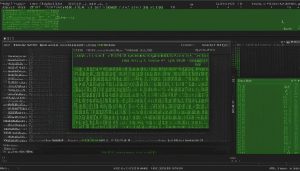Elementary OS is a Linux distribution that serves as a thoughtful, capable, and ethical replacement for Windows and macOS. It is designed to be easy to understand and pick up for new users, while also offering powerful features for more experienced users. With its pay-what-you-can model, users can download and use Elementary OS at any dollar amount. The latest version, Elementary OS 7.1 Horus, introduces new personalization options, enhanced privacy features, and over 200 bug fixes, design changes, and new features.
Key Takeaways:
- Elementary OS is a Linux distribution designed to replace Windows and macOS.
- It is user-friendly for new users and offers powerful features for experienced users.
- Users can pay what they can or choose any dollar amount to download and use Elementary OS.
- The latest version, Elementary OS 7.1 Horus, brings new personalization options, enhanced privacy features, and numerous bug fixes and improvements.
- Elementary OS offers a compelling alternative to mainstream operating systems.
Features of Elementary OS
Elementary OS offers a plethora of features that cater to the needs of both new and experienced users. Its carefully considered set of apps covers everyday tasks and provides a seamless computing experience. The apps included in Elementary OS are designed to be intuitive and easy to use, while still offering powerful functionality.
Some of the key apps included in Elementary OS are:
- Music player
- Web browser
- Photo organizer
- Video viewer
- Calendar
- File manager
- Terminal emulator
- Code editor
These apps ensure that users can accomplish their daily tasks without the need for additional software installations.
Elementary OS also prioritizes security and privacy. With features such as app permissions, personal data control, and automatic file cleanup, users can have peace of mind while using the operating system. Additionally, the source code of Elementary OS is fully accessible, allowing users to modify and redistribute it according to their requirements.
Whether you’re looking for a user-friendly interface or powerful productivity features, Elementary OS has you covered.
Table: Comparison of Elementary OS Features
| Feature | Description |
|---|---|
| Intuitive Apps | Includes a variety of apps for everyday tasks that are easy to use. |
| Security and Privacy | Prioritizes security and privacy with features like app permissions and personal data control. |
| Open Source | The source code is fully accessible and can be modified and redistributed. |
Installation and User Guide for Elementary OS
Getting started with Elementary OS is quick and hassle-free. Here’s a step-by-step guide to help you with the installation process:
- Visit the official Elementary OS website at https://elementary.io/.
- Click on the “Download” button to access the download page.
- Choose the amount you want to contribute or enter any dollar amount. Remember, Elementary OS follows a pay-what-you-can model.
- Select your download option based on your computer’s architecture (32-bit or 64-bit).
- Once the download is complete, create a bootable USB drive using software like Rufus or Etcher.
- Restart your computer and boot from the USB drive.
- Follow the on-screen instructions to install Elementary OS. The installer will guide you through partitioning your hard drive and selecting your preferences.
- Once the installation is complete, reboot your computer, and you’ll be greeted with the beautiful Elementary OS desktop.
Once you have Elementary OS installed, you can refer to the user guide and documentation provided by the Elementary OS team for further assistance. The user guide covers various topics, including system settings, app management, and customization options. It’s a comprehensive resource that will help you make the most out of your Elementary OS experience.
If you ever need support or have questions, you can turn to the active Elementary OS community. The community forums are a great place to connect with other users, ask for help, and share your experiences. Additionally, there are numerous online resources, tutorials, and guides available that can assist you in troubleshooting issues or exploring advanced features.
Table: Elementary OS System Requirements
| Minimum Requirements | Recommended Requirements |
|---|---|
| 1 GHz dual-core processor | 2 GHz dual-core processor or higher |
| 2 GB RAM | 4 GB RAM or more |
| 15 GB available storage | 30 GB available storage or more |
| 1024×768 display resolution | 1366×768 display resolution or higher |
| Internet connection for updates and downloads | High-speed internet connection for optimal performance |
Design Philosophy of Elementary OS
Elementary OS is known for its design philosophy that centers around immediate usability and a gentle learning curve. The desktop environment, known as Pantheon, features a visually pleasing and user-friendly interface that prioritizes simplicity and accessibility over heavy customization options. The developers of Elementary OS believe in the power of concision, accessible configuration, and minimal documentation.
Intuitive Interface: Pantheon Desktop Environment
The Pantheon desktop environment is the heart of Elementary OS’s design philosophy. Its clean and elegant interface resembles macOS in certain aspects, but the developers maintain that any visual similarities are unintentional. The Pantheon desktop provides users with a visually appealing and clutter-free workspace, allowing them to focus on their tasks without unnecessary distractions.
One of the key principles of Pantheon is immediate usability. The interface is designed to be intuitive, making it easy for both new and experienced users to navigate and find what they need. The application launcher, top panel, and dock provide quick access to commonly used apps and system settings, streamlining the user experience.
Accessibility and Ease of Use
Elementary OS strives to be accessible to everyone, regardless of their level of technical expertise. The design philosophy emphasizes simplicity and ease of use, enabling users to quickly and easily understand how to perform common tasks. The consistent and streamlined user interface ensures that users can navigate the operating system effortlessly.
Minimalism and Attention to Detail
The design of Elementary OS is characterized by its minimalistic approach and attention to detail. The developers believe in providing a clutter-free environment that allows users to focus on their work. Each element of the interface is carefully crafted, from the icons to the typography, to create a visually cohesive and aesthetically pleasing experience.
By prioritizing simplicity, accessibility, and attention to detail, the design philosophy of Elementary OS sets it apart from other operating systems. The Pantheon desktop environment provides users with an intuitive and visually appealing interface that enhances productivity and ease of use. Whether you are a new user or an experienced one, Elementary OS offers a thoughtfully designed platform that promotes a seamless computing experience.
Multitasking and Productivity in Elementary OS
Elementary OS offers several features that enhance multitasking and productivity, making it a powerful operating system for users who need to efficiently manage their tasks and workflows. These features provide a seamless and organized computing experience, allowing users to stay focused and accomplish more in less time.
Multitasking View
One of the key productivity features in Elementary OS is the Multitasking View, which allows users to effortlessly switch between open windows and workspaces. With a simple keyboard shortcut or a swipe on a touchpad, users can access a visual overview of their tasks, making it easy to quickly navigate between applications and stay on top of their workflow.
Picture-in-Picture
Another useful feature in Elementary OS is Picture-in-Picture mode. This feature allows users to keep important content, such as videos or presentations, visible on their screen while working on other tasks. Whether you’re watching a tutorial or attending a virtual meeting, Picture-in-Picture ensures that you can stay focused on your work without missing out on important information.
Do Not Disturb
In Elementary OS, the Do Not Disturb feature helps users stay focused by temporarily blocking notifications. When enabled, users can work without interruptions, ensuring that they stay in the productivity flow. Whether you’re working on a project that requires deep concentration or simply want to minimize distractions, Do Not Disturb provides a valuable tool for maintaining productivity.
Workspaces
Workspaces in Elementary OS allow users to create separate virtual desktops, enabling them to organize their tasks and applications more efficiently. With Workspaces, users can group related applications together and switch between them with ease, reducing clutter and improving focus. This feature is especially helpful for multitasking and managing complex projects.
Whether you’re a student, professional, or creative, Elementary OS provides a range of multitasking and productivity features to help you work smarter and more efficiently. With the Multitasking View, Picture-in-Picture mode, Do Not Disturb, and Workspaces, you can take control of your workflow and achieve more in less time. Discover the power of Elementary OS and experience a seamless and productive computing environment.
Conclusion
Elementary OS provides a compelling alternative to mainstream operating systems like Windows and macOS. With its thoughtful design, user-friendly interface, and powerful productivity features, it offers a seamless computing experience. Whether you’re a new user seeking a straightforward and intuitive operating system or an experienced developer looking for customization and open-source opportunities, Elementary OS has something to offer.
One of the key strengths of Elementary OS is its active community and comprehensive documentation, making it easy to get started and find support. Whether you need a user guide, a review, or assistance with any aspect of Elementary OS, the resources are readily available. This thriving community ensures that users have access to a wealth of knowledge and expertise.
If you’re ready to explore a new computing experience, download Elementary OS today. Discover how this Linux distribution can enhance your productivity, streamline your workflow, and transform the way you use your computer. Join the growing community of Elementary OS users and unlock the full potential of your device.
FAQ
What is Elementary OS?
Elementary OS is a Linux distribution that serves as a thoughtful, capable, and ethical replacement for Windows and macOS.
What are the features of Elementary OS?
Elementary OS offers a range of features, including a carefully considered set of intuitive apps for everyday needs, enhanced privacy features, customizable personalization options, and over 200 bug fixes, design changes, and new features in the latest version, Elementary OS 7.1 Horus.
How do I install and use Elementary OS?
Users can download Elementary OS from the official website, either by paying what they can or entering any dollar amount. The installation process is straightforward and guided, making it accessible for new users. User guides, documentation, and support are available through the Elementary OS community and online resources.
What is the design philosophy of Elementary OS?
Elementary OS focuses on immediate usability and a gentle learning curve. The desktop environment, Pantheon, provides a visually pleasing and user-friendly interface, prioritizing simplicity and accessibility over heavy customization options.
What multitasking and productivity features does Elementary OS offer?
Elementary OS offers features such as Multitasking View for easy window and workspace switching, Picture-in-Picture mode for keeping important content visible, Do Not Disturb mode for blocking notifications, and Workspaces for organizing tasks. Customizable keyboard shortcuts enhance productivity and efficiency.
Where can I find support for Elementary OS?
Elementary OS provides user guides, documentation, and support through its community forums and online resources.
Hi, I’m Mark, the author of Clever IT Solutions: Mastering Technology for Success. I am passionate about empowering individuals to navigate the ever-changing world of information technology. With years of experience in the industry, I have honed my skills and knowledge to share with you. At Clever IT Solutions, we are dedicated to teaching you how to tackle any IT challenge, helping you stay ahead in today’s digital world. From troubleshooting common issues to mastering complex technologies, I am here to guide you every step of the way. Join me on this journey as we unlock the secrets to IT success.


